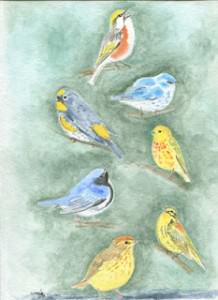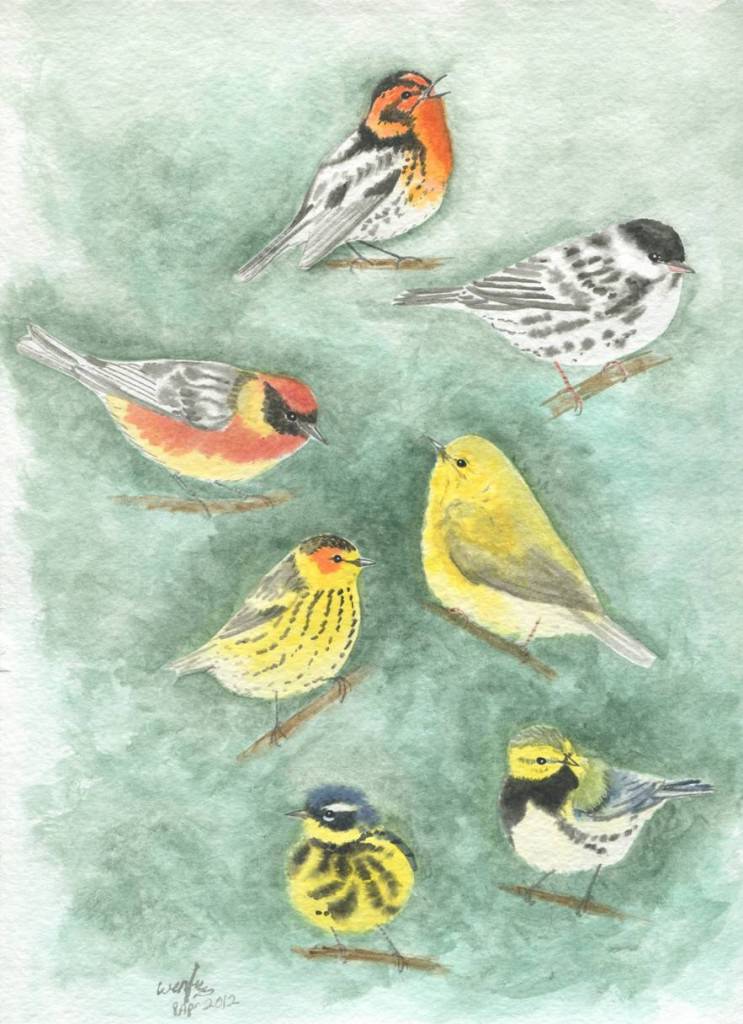A Timetable of Migration at Mount Auburn in May
Jessica Bussmann March 15, 2024 Plants & Wildlife

The month of May is when the peak abundance of migrant birds is found at Mount Auburn. In the following week by week timetable is a rather unscientific schedule of when you might expect the optimal time to see certain species. The third week of May is probably the week in which you could see close to 100 species in the Cemetery. This week you still have a few stragglers from the last days of April and the first few of the birds that come in the last days of May. Remember that as the month progresses, the foliage gets thicker, so the earlier in the season that you can find a migrant, the easier it will be to see it!
By the first week in May, many migrants will already be present such as Northern Flicker, Eastern Phoebe, Blue-headed Vireo, both Golden and Ruby crowned Kinglets, Hermit Thrush, Blue-gray Gnatcatcher, and the following early warblers: Yellow-rumped, Pine, Palm and Black and white, Chipping Sparrow and Eastern Towhee.

Early morning is often the best time of day, all birds are singing and the areas around Halcyon and Auburn lakes and Willow Pond are best early, the Dell is often later in the morning and by 10 AM birds tend to quiet down and begin to feed more.
First Week of May: Spotted and Solitary sandpipers, Chimney Swift, Eastern Kingbird, Great Crested Flycatcher, House Wren, Wood Thrush, Gray Catbird, Warbling Vireo, Parula, Nashville, Yellow, Black-throated Green warblers, Ovenbird, Northern Waterthrush, Baltimore and Orchard Orioles.
Second Week of May: Ruby-throated Hummingbird, Least Flycatcher, White-eyed Vireo (uncommon), Veery, Chestnut-sided, Magnolia, Cape May (uncommon), Black-throated Blue, Blackburnian, Redstart, Common Yellowthroat, Scarlet Tanager, Rose-breasted Grosbeak and White-crowned Sparrow.
Third Week of May: Yellow and Black-billed cuckoos, Common Nighthawk, Swainson’s Thrush, Gray-cheeked-Bicknell’s Thrush (uncommon), Cedar Waxwing, Red-eyed Vireo, Tennessee, Bay-breasted, Blackpoll, and Wilson’s warblers, Lincoln’s Sparrow and Bobolink.
Fourth Week of May: Eastern Wood pewee, Alder Flycatcher, Acadian Flycatcher (rare), Olive-sided Flycatcher (uncommon), Canada and Mourning warblers.
Setophaga Warblers Watercolours by Wenfei Tong. Formerly a PhD candidate in evolutionary biology at Harvard, Dr. Wenfei Tong enjoyed birdwatching at Mount Auburn Cemetery when she lived in this area (in addition to photography and painting). Visit her blog darwin’s jackal or check out some of her bird photos on flickr!
Bob Stymeist is Bird Observer's Bird Sightings Compiler and a regular bird walk leader for the Friends of Mount Auburn.

Comments
Comments for this post are closed